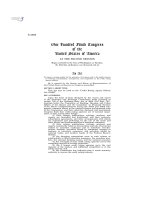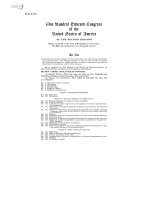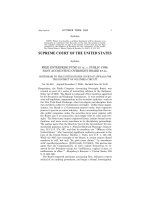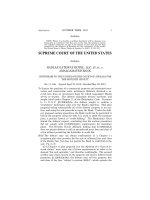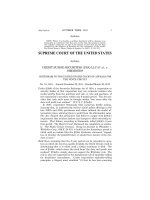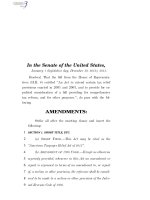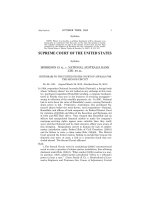Implementation of New Accounting,,Standards of the United States Washington _part2 ppt
Bạn đang xem bản rút gọn của tài liệu. Xem và tải ngay bản đầy đủ của tài liệu tại đây (1.77 MB, 11 trang )
Implementation of New
Accounting,,StandarcJs i
While the FASAB completed work
on a basic set, of accounting standards
in 1996, ‘some standards did notlbe-
come effective until fiscal
i 998.
Standards becoming effective infis-
cal 1998 require that the value of na-
tional defense.assets be removed
from the Balance Sheet and that in-
formation about these assets be,re-
ported in the Stewardship Informa-
tion’section of the Financial Report.’
These’assets were valued at $655.2
billion when reported on the fiscal
1997 Balance Sheet. FASAB has ini-
tiated a project’to identify and re-
search user information needs for na-
tional.defense assets.
In addition, standards effective for
the first time in 1998,,require current
services assessment information
shotiing,bo& the short-term and me-
dium-term ‘direction of current pro-
grams. The ,c,ui;rent.services.assessr
ment presents actual’receipt and
outlay data for all programs for the
year for which the financial state-
ments are prepared (the base year)
and estimates for 6 years subsequent
to the base year. ,This assessment will
thus facilitate evaluation of the sufti-
ciency of future resources to sustain
public services and to meet current
and future obligations as they become
due.
Standards becoming effective in
future years require reporting of an-
nual Federal expenses for steward-
ship investments, which include:
: Non-Federal physical property:
the Pederal investment in proper- 8
ties owned by State and local gov-
ernments (e.g;, highways’and
airports).
l
Human capital: investments in
education and training programs
financed by the U.S. Government
for the benefit of the public.
l
Research and development: the
U.S. Government’s investments in
basic and applied research and de-
velopment.
The annual expense related to these
investments included in the State-
ment of Net Cost will be separately
identified in the Stewardship Infor-
mation section.
on the US. economy,, chiefly
through exports and volatility in II-
flatioirdropping to levels not seen
since the mid;1 960,‘s. Strong
nancial markets,:but the domestic ,growth in incomes and a rising
ecbrikny surged forward. Job gains
stock market led to a boost in Fed-
Very strong economic growth
were very solid over the year ending
era1 tax receipt& fiscal 1998, con-
continued through fiscal 1998. The
in September and the nnemploy-
tributing to the fast Federal unified
ment rate heldnear 28-year lows., At budget surplus .in29 years. ,S’l
Asian f&mcial crisis and weakness the same time, inflation wasvery
abroad.had some negative impacts
well contained, with the rate of in-
The Economy
in ‘Fiscal
1998
Re,al, gross domestic product
(GDP) grew by 3 .< percent across the
four quarters of fiscal 1998 (which
encompasses the fourth quarter of
calendar 1997,through the third quar-
ter‘of calendar 1998). Over the past 3
fiscal years, real giotith averaged a
robust 3.7 percent.
’ ‘The household’sector accounted
for:muc$ of the gain’in 1998, with
consumer spending and residential
jnv@nent growing very rapidly.
C,onsumer purchas,es swelled by 4.7
percent over the fiscal ye.ar, the most
rap~id’rate of advance“iir~,l~ years.: In-’
best,@t in nek h,,&$j$@pe& ,jj;;
12 percent and the home-otinkrship
rate hit an all-time high. .T@gains in
spending were fueled by ‘rising ,eni-
ployment and income and by the
wealth effects of the rapid increases
in stock prices over the past few
years.
Partly offsetting strength in the do-
mestic economy was a sizable deteri-
“”
Gr&nkh of Real GDP, 11
1
5
,^
-1. ’
I
I I 1 I I I
I ’
89, 90
,91 92
93
,94 ,95
98
97 98
F,ischl years
This is trial version
www.adultpdf.com
,6
DISCUSSION AND ANALYSIS
oration in the foreign trade balance
due to weakening global financial and
economic conditions. U.S. exports in
real terms fell by 2.3 percent over the
fiscal year, while imports grew by 8.3
percent. The widening trade deficit
acted as a,considerable drag on real
GDP growth, particularly in the first
half of calendar 1998 when it sub-
tracted more than 2 percentage points
from growth. U.S. agricultural and
manufacturing industries were most
affected by the loss of exports and
other consequences of the global situ-
ation: Manufacturing production and
capacity utilization slowed over the
year, and factory employment de-
clined by 137,000 from March
through September.
Employment growth in other sec-
tors of the economy was very strong
in fiscal 1998, and labor markets con-
tinued to be very tight. About 3.1 mil-
lion jobs were added during the year,
the same as, in the previous fiscal
year. The unemployment rate held
between 4.3 and 4:7 percent through-
out the fiscal year, the lowest read-
ings in 28 years. The share of the
working-age population with a job
averaged 64 percent, a new fis-
cal-year record, and long-term unem-
ployment fell. Workers enjoyed an
acceleration in wage and salary
growth, which increased by 4 percent
over the fiscal year. This was consid-
erably faster than the rate of inflation
and resulte,d in solid gains.in real
wages and salaries. .
Despite strong economic growth
and ,very low rates, of unemployment,
price pressures did not build up’dm-
ing the year.,Falling prices forim-
ported goods,. energy and”food.held,,
down grow:th in cdmmodjty prices
and the’overall rate of inflation as ,,
well. Consumer prices edged up just
1.4 percent over the fiscal year, the
smallest inflation rate,since. the
mid-1960’s: Excluding the food,and
energy components, the underlying
“core” rate of consumer price infla-
tion was 2.4 percent, up a bit from 2.2
percent in the previous fiscal year,
which had been the lowest core rate
since the mid- 1960’s.
Budget Results
The expanding economy over
The unified Federal budget was
the course of the year brought a
in surplus by $69.2 billion in fis-
surge in tax revenue in 1998,
cal 1998, the first Federal surplus
which far outpaced modest gains
since 1969. This represented 0.8
in Federal outlays. Receipts in-
creased by 9.0 percent in fiscal
1998 to % 1,722 billion, faster than
gains over the previous several
“ihe expanding ’
years. Growth was led, by a more
economy over the
than 12 percent increase in indi-
course of the year
vidual income tax, payments, re-
flectmg rapid job and income’
brought a surge in
growth as well as high levels of
tax revenue in
1998,
capital gains from the rising stock
which far outpaced
market. That was more than
modest gains in
enough to offset a slowdown‘in
Federal outlays.”
corporate profits tax receipts,
which grew by 3-112 percent in
fiscal 1998 compared with 6 per- ’
cent in the prior year. Corporate
percent, of GDP, the highest share
profits weakened a bit over the
of GDP for a surplus in more than
year primarily due to the impacts.,
40 years, and resulted in a reduc-
of the global situation on earnings, ’
tion in the level of Federal debt
particularly among manufacturing
firms.
held by the public for the first
time in 29 years. Passage of de%
Growth of outlays was held to”
tit reduction programs in con-
just 3.2 percent in fiscal .1998,
junction with strong economic
with outlaysrising to $1,653 bil-
growth placed the budget on its
lion. ‘Qutlays in relation to GDP
path toward surplus after the an-
were the smallest since 1974, dip-
ping to a 19.7 percent share from
nual deficit,reached an all-time 20.0 percent in fiscal 1997. The
high of $290 billion in fiscal
1992:
underlying improvement over the
5,
year was even greater than the
Unified Federal Budget Moves
from Deficit to Surplus
69 74 79 84 89 94 99 04
Fiscal year
This is trial version
www.adultpdf.com
,. ”
summary figure suggests, as outlays
in fiscal 1997 were held down by
large’inflows to the deposit insurance
account which were not repeated in
fiscal 1998. (These inflows are
treated as negative outlays in budget
accounting.)’ Excluding the deposit
insurance account and other similar
factors,‘outlays increased by less than
2-l/2 percent in fiscal 1998.
Defense spending dipped slightly
in fiscal’year 1998 after increasing by
$4.8 billion in the prior year. That in-
crease followed 4 years of reductions
in defense spending. Outlays for in-
come support (excluding Federal
retirement payments) were smaller
than a year ago, reflecting the expan-
sion of employment and rising in-
come in 1998. Net interest payments
declined by $0.7 billion. Growth in
Medicare slowed sharply compared
with previous years due in part to
slower processing of payments, but
expanded use of managed care plans
and lower-than-expected payments
for inpatient hospital services also
contributed.
The unified budget in fiscal 1999 is
expected to post a slightly larger sur-
plus than the $69.2 billion recorded in
fiscal 1998. New projections from the
Fiscal Year 2000 Budget show sur-
pluses growing throughout the fore-
cast horizon, accumulating to $2.4
trillion over the period 2000-2009.
These results are similar to the fore-
casts of the Congressional Budget
Office, which yield an even larger cu-
mulative surplus of $2.6 trillion over
that 1 O-year span.
Revenue
Non-exchange revenue is the U.S.
Government’s primary .source of reve-
nue, and totaled $1,712.8 billion in
1998. More than 95 percent of this to-
tal came from tax receipts, with the re-
mainder coming fioin customs duties
and -other miscellaneous receipts.
Earned revenues are inflows of re-
sources that arise from exchange
transactions. Exchange transactions
occur when each partyto the transac-
tion sacrifices value and receives
value in return for example, when
the U.S. Government sells goods or
services to the public. During 1998,
the U.S. Government earned $1,689
billion in exchange revenue including
$2.8 billion from the sale of the Elk
Hills Naval Petroleum Reserve by the
Department of E,nergy. Of these reve-
nues; $16 1.5 billion are offset against
: the gross cost of the related functions
to arriveatthe function’s net cost. The
US. Govefnment also earned $7.4 bil-
lion that was not offsetagainst the cost
of any function, e.g., royalties, on the
Outer Continental Shelf-lands.
,,
1 1.4% Miscsllaneo~
, ,3.4%
1.6%
by Major Souice
Detail may not add to totals due to rounding.
,
This is trial version
www.adultpdf.com
8
DISCUSSION AND ANALYSIS
Expenses by Function
The net cost of U.S. Government oper-
ations was $1,854 billion for 1998. Net
:cost represents the gross cost of opera-
tions less attributable earned revenues.
The Statement of Net Cost reflects the
cost incurred to carry out the national
priorities identified by the President
and the Congress and how the net cost
was financed. The functions and
subfurctions used to accumulate costs
associated with the national priorities
are identified in the President’s .budget
and describedin detail in the Supple-
mental Information section of this re-
port. The accompanying chart presents
the percentage of the net cost of U.S.
Government operations represented by
each of the U.S. Government’s major
functions.
Net Cost
by
I
.,
,. /.
Detail may not add tb totals due to rounding.
Asset& .’ ,“‘l 1 ;
I>,: .,.,
i ; “; “‘;>, ,,
f The &s&s otthe U.S. Govem&nt ‘. ’ Major ‘&&wieo
$e the resources~,available to pav lin- ”
., 1-v
- -
b;rlities or to ‘satisfy future se_
rvice
Asset?,
~. _
vneeds. The a~c.ii~~~~yins,:chartde-
picts the major’%~~go~es’-~~~~p
assets as of Septemb&.Jd: 1s
_ ldrteci
)98 as a
piercentage of rep,orte$#otal as&s.
I.
Detailed information&out ,the coni:
ponents of these asset categories can
I
,A
I::
‘,b:e found in the notes tdth,e:,$nancial,‘,,
statements. The’ assets presented-on
“’
the Balance Sheet are not a compre-
I
hensjve listof Federal resources. For
examplej’the,U~S. .Govermuent’s-most
iinpdktarit’ fin;?;cial:-~~~o~c~;
1 j _ _ _ -_ _
its ~_
abil-
35.1% Property, plant and gq.i.,@m.&t
ity td:t~.~d.r~~l~~e,cd~erce, cm-
I I
not be quantified and is not reflected.
I I
19.6% Inventories and relate$pr&et-ty
Natural resources, stewardship land
19 6% Lnsmc rn-nitmhln ~
rl * ‘AO, ,
(national parks, forests and glazing
lands),,national defense assets and
heritage assets are other examples of
resources that are not included in the
$852.8 billion of Federal assets re-
ported on the Balance Sheet at the end
of fiscal 1998.
.“UI I* I~“~IIYauI= 1
i
IL.L~TO
Cash and other monetary assets
7.0% Other
4.2% Accounts receivable
L
3.2% Taxes receivable
r
Detail may not add to totals due to rounding.
This is trial version
www.adultpdf.com
I
DISCUSSION .AND ANALYSIS 9
Liabilities:
Major Categories
At the end of fiscal 1998, the U.S. of Liabilitie% :
Government reported liabilities of
$6,987.2 billion. These liabilities are
probable and measurable future out-
flows of resources arising out of past
transactions or events. The largest
component,‘of these liabilities
($3,7 17.7 billion) is represented by
Federal.debt securities held by the
public. The next largest component
($2,685,1 billion),relates to pension,
~didabi,lity and ,health care costs for
veterans, and Federal’civilian and
military employees. Included in this
component is a D,epartment of,Vet-
erans Affairs program whereby veter- :’
1.1% Benefits due and payable
:,,_ .:
c
,;
which will llkely;3 .,: -
:.
require substantial
., future budg@tary
:resources to liiquidate,
is,related to., )’
enVironmgntal. :
The IJ.S. .Government has substantial~future commitments to
cle8ilup’costs.j’
sins or their dependents receive com-
pensation benefits if the veteran was
disabled or died from military ser-
.vice-connected causis’.‘Change$$i
the actuarial methodology and the. iti-
‘, terest rate assumption resulted in a iii
ability increase of $3 8 1 billion. This
liability increase cot&d with the, ret
m&al from ,the Balance, Sheet of
‘, $655.2.billionin national,lefense’ass-
sets, tiere .me.major factors m causmg “,
: th$$net,positlon of the U.S. Govern-‘, :
m’ent to,,decrease by’$‘l$l trillion’in
fiscal, 1998. The national defense as-
sets *ereremoved from the Balance’
Sheet: as aresuit of.implementing a
n$$ accotintingstanclard.,
Another ‘liability,,vvhich will likely
require substantial ,future budgetary .:
resources tohquidate,~ is,related to en- L
vironmental cleanup costs. As,of Sep-
tember 30, i998, the’ cost of cleaning
up environmental contamination was
estimated to be $224.5 billion. The
accompanying chart presents the per-
centage of total Federal liabilities rep-
resented by each of the categories of
liabilities reporte,,d ,on the B,alance
Sheet: Additional,;details about the
U.S. Govkrniiient’s re@ted liabilities
can be found in the notes to the fman-
cial statements.
;.Two~trust funds have been es-
tablished,by law to finance the So-
cial:Security program ,(OASDI):
Federal Old-Age,,and Survivors
Insurance (0,ASI) and Federal
Disabrlrty Insurance (DI). .OASI
pays retirement and survivors
benefits :, and DI pays benefits af-
ter’a’worker becomes disabled.
OASDI revenues consist prima&
ily of taxes on earnings that are
paid by employees, their employ-
ers, and the self-employed.
OASDI also receives revenue
from taxation of part of Social Se-
curity benefits. Revenues that are
not needed to pay current benefits
or administrative exnenses are in-
“The A&ifi&&on :’
lnte’+d&,:~o ?.‘ik‘
with ,C6ng@s on a ,I)
bipartisan basis to
enact long-term
Social Security
solvency ,and
reform in 1999.”
earn interest for the trust funds.
The securities issued to the trust
funds are guaranteed as to both
vested,in Treasury~se~curities to
I : 7 ,, ,!.’ “Z:;,,.
principal id interest and backed
.,:
I? “’
, ,, ,::.,. 3;,
I ,’
/ ‘,
., I>,‘,
,,I. 4,
., :’
‘y
?. :
,’
This is trial version
www.adultpdf.com
IO
DISCI~SSION AND ANALYSIS
“With nq D than Ige,In a.
the program,l’in?Z i&l3
the tiust funds are
expected to. begin
by the full faith and credit of the U.S.
Government.
using interest ;on their
The Board of Trustees of the OASI
investments :to cover
and DI Trust Funds provides the Pres-
the caqh shortfall and
ident and the Congress with
to pay benefi@.”
short-range (10 years) and long&nge
(75 years) actuarial estimates of each
,
trust fund:Because of the: inherent
uncertainty in estimates for as long as
crease in life expectancy and a de-
75 years into the future, the Social Se-
cline in the birth rate). For example,
curity Trustees use three alternative
in 1960, 5.1 workers paid for every
sets of economic and demographic
beneficiary. Today, the ratio of work-
assumptions to show a range of possi-
ers to beneficiary is’3.4 to 1 and 32
bilities:Most analysts use the
years from now; when all of the baby
Trustees’ intermediate, or “bestesti-
boom generation has retired, the ratio
mate” set of assumptions to’evaluate
will drop to approximately 2 to 1. The
the
retireme,nt component of the program
financial condition of ,the:,Social ,! is’,
Security program. ‘. : ~ ,‘_(‘, ., 4%: :1 i:; ;- :
financed,. ‘larg,ely: .’ own,; a
The 75-year estimams ~assumethat :,
“pa~-~s~~j;l’o~~~o”,~a~ii$;,i.e:;:c~~ent
future workers (except for those ,,
retirement benefits arelargely fi;
working ,m types of employment not
nanced by currentpayroll contribu-
mandatorily covered by the program)
tions
*
‘are covered
Under ‘current legislation and using
they
by; Social Security ,once
enter .the, .labor,force. The esti-
intermedi.ate assumptions; the
mates reflect the impact of the retie-
Trustees estimated in their i.998 reC
ment of the baby boomers, as well as
port that by 2013)cash disbursements
changing demographics (e.g., an in-
for the programs will exceed cash.,re+
, ceipts and by 2032 the combined trust
fund assets, primarily investments in
Treasury securities; w,ill be ex-
hausted. With. no change. in the pro-
gram, ,in,‘20 13 the, trust funds are, ex-
pected to begin using interest on their
investments to cover the cash short-
fall and to pay benefits. Starting in
2021, they’would.begin redeeming
their investments in Treasury securi-
ties to provide the needed funding. In
,2032 trust fund assets would be ex-
hausted; at that time, dedicated tax
revenues wouldbe sufficient to pay
approximately 75 percent of the ben-
efits due. .( _’
The,Ad.ministration intends to
work with Congress on a bipartisan
basis to enact long-term Social Secu-
rity solvency and reform in 1999.
Acting sooner rather than later to ad-
dress the long-term financing needs
of the program will make the required,
changes less ‘severe and disruptive
and ensure tliat~SocialSecurity works
as well for future generations as it has
for past generatio&‘Additional in-
formation about the Social, Security
program can be found in the Steward-
ship Information section of this Fi-
nancial Report. ,,
‘Two trust funds have been es-
tablished to finance the Medicare
Budget Act of 1997 provides
that ‘the SMI premium is set at
program. The Medicare Part A 25 percent ,of,program costs.
Hospital Insurance (HI) Trust ‘The, remainder of the costs is
Fund is financed,by a 2.9 percent ’ fbridedby,Con@essional appro-
tax on wages and salaries required , priations:
II ,’
:, : ,
/‘.
to be‘paid’equally by employees
‘and employers. The Medicare Part
The 11998 trusteesl report’ pro;
jects that the HIltrust fund’s’as;
‘B Supplementary Medical Iiisur-
,, :\
,, :
;, .,l’
sets will be depleted by 2008~1.~
since (SMI) Trust Fund receives : ing intermediate or “best
,;-,
premium payments on behalfof estimate” assumptions., Addi-
:,
Medicare beneflciariks’who have tional information about the
”
elected c,overage. The Balanced Medicareprogram can be fotmd
in the Stewardship ,Information
/
section of this Pinancial Report.
,. .,
(,
.’ 1.
,
0
“,.
,.
This is trial version
www.adultpdf.com
,i
,,.
1
DISCUSSION AND ANALYSIS II ,I
._ ,.,
I
The, Administration’s Priority ment to receive an unqualified opin- tions between agencies. The audit of
Management Objectives included in ion on its financial statements. The the U.S. Government’s financial
the fiscal 1999 and 2000 Budgets of’ exhibit oathe following page corre- statements for fiscal 1997 disclosed
the U.S Government include im- lates’the most critical problem areas that agencies cannot effectively iden-
proving financial management with the agencies responsible for tak- tify transactions with other agencies
information as,part of its plan for ingcorrectiveaction. Theexhibitalso so they can be eliminated for
strengthening Governmentwide man-
agement. Audits of agency financial
highlights that the Department of De- governmentwide reporting. If these
I
statements disclose that agencies
transactions are not properly elimi-
nated, total U.S. Government assets,
have made substantial progress in
liabilities, revenues and expenses
correcting fmancial management de-
will be misstated by the amount of
ficiencies that impede compliance
“Audits of agency
with Federal accounting standards
financial statements *e~e’~~~o~;mment’s
ability
to
and, accordingly, improved fmancial
disclose that agencies
correctly identify these items im-
management. The following exhibit have ma& substantial p
roved in fiscal 1998. In addition, the
illustrates agency progress as mea-
Administration has organized a task
sured by the increasing number of un-
progress in correcting f
orce to address the intragovernmental
qualified audit opinions orrtheir fi- financi;ll
management
transactions issue. The task force ex-,
nancial statements. (Audits for all of
the 24 major agencies were not re-
’ deficiencies . .‘! ’ , future
pects to domplete its work in the near
quired until fiscal 1996.) In addition to the foregoing obsta-
While progress has been made, re- cl&, because the U.S. Government
cent audits disclosedthat major agen- ’ calculates the budget surplus on the
ties continue to have serious finan- basis of cash receipts and disburse;
cial management problems, which fense has serious deficiencies in all ments and cahzulates operating re-
preclude compliance with numerous
Fed,eral accou&igstandards. These
but one issue area and all agencies sults for fmancial statement purposes
haveproblems with,accounting for on the accrual basis ofaccounting,
agenciesmust satisfactorily address
these problems ‘in order to receive an
intragovermnental transactions. Treasury must, but currently cannot,
With respect to intragovernmental reconcile these two amounts in order
unqualified opinion on their fmancial transactions, the problem pertains to to fully explain to readers why the re-
statements and for the U.S. Govern- identifying and eliminating transac- ported amounts differ.
:
r
or A?t@pz$lwg, ,!,Jhqyalified Audit Opinions
<for the, ?+a1 y6,ars Indktited
(Oi,24,agencies’covered),
. .
1991
1993
‘.
1996 1997 1998* 1999* 2000*
1 1 .6 11 13 20 23**
* Anticipated results
** DOD does not anticipate an unqualified opinion on its financial statements before the year 2003.
This is trial version
www.adultpdf.com
L
12
DISCUSSION AND ANALYSIS
L
”
,;
.’
Obstacles
to an Unqualified Opinion, ”
,i, ^.
t
il
of the Financial Statem@&
of the U.S.
Governmd~; :I, e. ‘-I) ! ‘, :I : :.! ‘s ., ‘,
: .;, I
., -, ; ,, ; :. :,,. _
Loans,
I.
Accounts
Pension, I’ lntragovern-
‘Property, Receivable Environ-
Health
Wecon- mental
Entity
,Plantand i, and Loan mental
and Other tiled Dis- Transac-
Equipment Inventory ,Guarantees Liabilities Liabilities ,bursements : tions
u&i (
,, ,I$’
‘/
.’
,.x,. ,, x
X.
POP ,, :. , x,
x’ x’ x x x
Education
X X
HHS:, _:
‘,
x ‘, x
‘OP’M ‘, I/ I,
All other
I,
The President’s Budgk for fiscal A team of senior’managers from
1999 set as a goal an unqualified the OMB, the Treasury, and the
The OMB, the Treasury, and the
opinion on the IJ.,S. Government’s , ,GKO met with >enior agency dffi-
GAO are monitoring agencies’ prog-
” fina&ial statements. Thi: Prkident cials to discuss agency plans and
ress by (1).reviewing quarterly prog-
issued a Memorandum to the Heads
prospects for successfully meeting
ress, reports fr?rn all the agencies
of Fe,deral Agencies on May 26,
planned goals. The conclvsion of the .,
liTted .in the. aforementioned e&bit
1998, advising them of the Admin-
team is that, while progress has been
on their firogress in meeting tlie goals
’ istratlon’s goal and directing them to
and milesioties’set out ii the action
develop corrective action plans for
made since the March 1998 release
add&sing obstaclds to achieving
of the report on audit of the fiscal
plans required by the President’s May
1997 financial statements of the U.S.
‘the goal and to submit quarterly
26, 1998, Memorandum;‘(;?j meeting
Government, much remains to be
progress reports. All named agen- done in the areas presented in the
regularly with officials of those agen-
ties with the most formidable obsta-
ties submitted the required plans aforementioned exhibit.
and progress reports.
cles to their progress in adhieving
planned goals; and, (3) providing net-
j
essary advice and assis.tice.
This is trial version
www.adultpdf.com
: There is no more immediate man-
agement challenge:facing the U.S.
Government and industry worldwide
than the impending shift of dates from
the year 1999 to the year 2000. The
Administration is committed to en-
suring that Federal agencies.meet the
challenges posed by the Year 2000
(Y2K) computer problem. Since No-
vember, the U.S. Government has
made substantial progress toward fix-
ing the problem. As of February 12,
1999:
l
Of the’ 6,399 mission critical
systems, 79 percent are now fully
com$ant, up from 61 percent in
December. These compliant sys-
terns include systems that have
been repaired or replaced as well
as those that were already compli-
ant.
l
Of the remaining 1,354 mission
critical systems that are not yet
compliant, 966 (71 percent) are
being repaired, 270 (20 percent)
are being replaced, and 118 (9
percent) will be retired.
l
Of the 4,130 mission critical
systems being repaired, 96 percent
have completed renovation, 87
percent have completed validation
and 76 percent have completed
implementation and are fully
compliant.
OMB, in cooperation with the Wes-
ident’s Council on Year 2000 Con-
version, continues to work closely
with individual agencies. Since De-
cember, most agencies have made
significant progress toward meeting
the governmentwide goals, although
several agencies remain behind
schedule. As of,February 12, 1999:
l
Five agencies (the Environmen-
tal Protection Agency, National
Science Foundation, Nuclear Reg-
ulatory Commission, Small Busi-
ness Administration and Social
Security Administration) report
that their mission critical systems
are now 100 percent compliant.
l
Three agencies (the U.S.
Agency for International Develop-
ment, Department of Health and
Human Services and Department
of Transportation) are not making
adequate ‘progress and have been
rated in Tier I.
Year 2000 Status
Mission Critical Systems
All Systems
S$stems Being kepihed
Y2K
Agency StatuSi
Assessment Rqnovatlon Validation Imp~oWaion
Compliant Complete Coniplete Complete
P
Tier III:
NASA, FEMA, Education,
OMB, HUD, Interior, GSA, VA,
SBA,. El?A,, NSF, NRC, SSA
Tier II:
Agricu’ktir&~ ‘Commerce,
Defense, Energy, Justice,
Labor, State; Treasury
Tier I:
U.S. Agency for liternational
Developm,ent, Heal!h and
Human Services,
Transportation
All agencies
96% 100% 100%
‘, /,
77% 100% 94%
63% 100% 98%
.99+%
96%
’ ‘
83%
74%
79% 42%
79% 100% 96% 87% 76%
This is trial version
www.adultpdf.com
14 DISCUSSION AND ANALYSIS
Agencies now estimate that, from
Fiscal 1996 through Fiscal 2000, they
1 will spend $6.8 billion fixing the
problem, an increase from the Febru-
ary estimate of $6.4 billion. This in-
crease is not unexpected, and OMB
and the Congress continue to work
’ closely with the agencies to ensure
that they have adequate funding
through aliocations from the supple-
mental contingent emergency re-
serve.,
While agencies expect that their
mission critical systems will ,be ready
, by December 3 1, they also. are devel-
oping business continuity and contin-
gency plans (BCCPs) to:ensure pro-
gram delivery in the, event of a system
failure or’malfunction, whether
.\, ,
within or outside the agency. Addi-
tionally, those agencies that are
behind schedule are emphasizing
completion of their remaining mis-
sion critical systems.
As agencies complete work on fix-
ing their mission critical systems,
they are now focusing on demon-
strating that programs and services,
especially those critical to public
safety, health and well-being, will be
operational. In addition, new guid-
ance from OMB will direct agencies
to work with other Federal agencies,
State and local governments, the pri-
vate sector, and others to assure the
readiness of 40 high-impact public
programs.
The Government Performance and useful to Congress, the President,
Results Act (GPRA:) makes U;S.
Government agencies more account-
a&agency management.
In fiscal 2000, agencies will sub-
able by focusing managers and policy mit to Congress and the President the
makers‘on’agency performance. tirst’of their annual reports on pro-
GPRA can fundamentally change gram performance. These reports,
how the U.S. Government carries out
covering fiscal 1999, will compare
’ its programs and makes funding deci- actual performance to the perfor-
sions. GPR4 requires-Federal agen- mance target levels in the annual
ties to periodically develop
plans for that year, and provide an
long-range strategic plans and armu-
ally prepare performance,plans and
.explanation for any goal not met.
,’
.: performance reports. The annual
With these reports, the fnst,phase of
‘GPR4 implementation will be com-
‘i,
plans set specific performance targets
plete.
for an agency’s programs and activi-
j_, i ties. The combination of GPRA plans
During fiscal 2000, agencies will
and reports ‘introduces an u’nprece-
also be revising and updating strate-
I dented degree of managerial and in-
gic plans for submission to Congress
and OMB by September 2000. All
stitutional accountability for accom- GPRA plans and reports are publicly
plishing program goals. Key to available, and can often be found on
achieving success is making the plans individual agency web sites.
1
._” .,.
(
This is trial version
www.adultpdf.com
GENERAL ACCOUNTING OFFICE REPORTS
I ,7
,.
,;;.
B-282041
Our report was prepared under the direction of Gene L. Dodaro, Assis-
tant Comptroller General, and Robert F. Dacey, Director, Consoli-
dated Audit and Computer’ Security Issues. If you have any questions,
please contact me on (202) 5 12-5500 or them on (202) 5 12-33 17.
j
,‘.
.’
David M. Walker
Comptroller General
of the United States
This is trial version
www.adultpdf.com
